Epoxy floor coating for garages is now a hit among homeowners. It’s durable, and looks great! This article will tell you how to get a professionally finished epoxy floor in your garage.
Prepare Your Garage Floor:
- Clean it, and repair any cracks or imperfections.
- After that, use a primer to make sure the epoxy sticks. Stick to manufacturer instructions on mixing and applying.
- Let the primer coat dry.
Now it’s time for the epoxy layer! Use a roller or brush.
To get a smooth, professional-looking finish, work in small sections.
You can even add decorative flakes or chips for extra oomph!
Allow the epoxy multiple coats to dry. This may take 24-72 hours, depending on humidity and temperature.
Also, make sure you ventilate the garage during application and curing.
Follow these steps and you’ll get a stunning garage floor with an eye-catching epoxy coating!
Discover: How To DIY Resin Floors
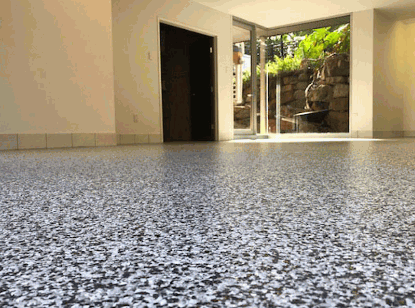
Preparing The Garage Floor
To prepare your garage floor for epoxy coating, begin by cleaning the floor thoroughly to ensure proper adhesion. Next, address any damaged areas by repairing and patching them. Lastly, allow the floor ample time to dry completely before applying the epoxy coating. This section focuses on the steps involved in preparing the garage floor, with sub-sections covering cleaning, repairing, and drying.
Cleaning The Floor
Clean the floor – essential to get your garage ready for activities. Remove dirt, debris, and stains for a safe place to work. Here’s a 6-step guide:
- Clear the space. Remove obstacles. Easy access.
- Start with sweeping or vacuuming. Include hard-to-reach spots.
- Choose a cleaning solution. General dirt/grime? Use mild detergent and warm water. Oil stains? Use a degreaser/stain remover.
- Apply the solution across the floor. Small sections. Mop or scrub brush.
- Scrub with a stiff brush/push broom. Extra pressure on tough spots.
- Rinse and dry. Use a hose/mop. Dry completely.
Unique details depend on the flooring material/condition. Manufacturer guidelines if available.
The history of garage floor cleaning dates back centuries. Ancient Rome used vinegar + volcanic ash to clean chariot house floors. This paved the way for modern techniques.
Clean the floor essential. Follow the steps. Consider unique details. Enjoy a pristine floor.
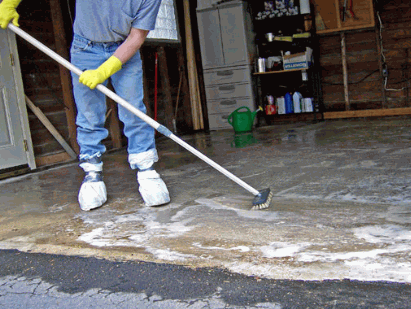
Repairing And Patching Any Damaged Areas
Repairing and patching any damaged areas of your garage floor is a must for a smooth and durable surface. Here’s a 5-step guide to help you:
| Step | Instructions |
|---|---|
| 1 | Inspect the floor for cracks, holes, and uneven surfaces. Document the size and severity of each affected area. |
| 2 | Clean the damaged area with a broom or vacuum cleaner. |
| 3 | Choose an appropriate repair material like epoxy resin or concrete patching compound. Follow product instructions for mixing and preparing. |
| 4 | Use a trowel or putty knife to evenly spread the repair material. Smooth it out and make sure it’s flush with the surrounding floor. |
| 5 | Allow the patch to dry/cure as recommended. Don’t step on or place heavy objects on the repaired area until it has hardened. |
Be sure to wear safety equipment like gloves and goggles when working with repair materials. Additionally, Bob Vila’s Home Improvement Encyclopedia states that concrete floors can crack due to factors like heavy loads, freeze-thaw cycles, and improper subfloor preparation.
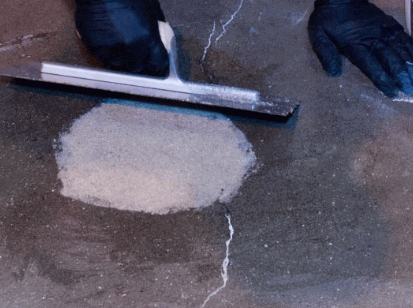
Allowing The Floor To Dry Completely
Clear the garage floor of all items!
Scrub it with a mild detergent solution, then rinse with a hose or pressure washer. Let it dry naturally, or use fans and dehumidifiers. Do a moisture test with a reliable meter to check if the floor meets manufacturer specs.
Proper ventilation is key during drying. Plus, apply a concrete sealer to speed up the process!
Applying Epoxy Coating
To achieve a beautifully epoxy-coated garage floor, follow these steps: Begin by choosing the right epoxy coating for your needs. Next, mix the epoxy components thoroughly to ensure proper adhesion and durability. Finally, apply the epoxy coating evenly onto the garage floor for a flawless finish. Each sub-section will guide you through the key elements required in this process.
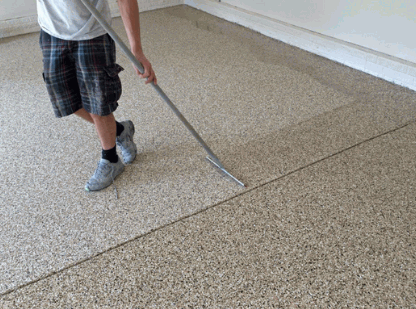
Choosing The Right Epoxy Coating
Choosing the right epoxy coating is key for a successful application. You have to think about the type of substrate, the environment, and the purpose. In the table below, you’ll find info on different epoxy coatings and their features:
| Epoxy Coating Type | Recommended Substrates | Chemical Resistance | Durability |
|---|---|---|---|
| Self-Leveling Epoxy | Concrete, wood, metal | High | Excellent |
| High-Build Epoxy | Masonry, concrete | Moderate | Very good |
| Water-Based Epoxy | Concrete, tile, drywall | Low-Moderate | Good |
| Metallic Epoxy | Concrete, countertops | Moderate-High | Very good |
For each type of epoxy coating, there are advantages and disadvantages. Self-leveling epoxy is easy to apply, but may not be suitable for surfaces with irregularities. High-build epoxy offers great durability but needs multiple coats for thicker applications. Water-based epoxy is eco-friendly, but may not be as resistant to chemicals.
Mixing The Epoxy Components
Gather the required equipment: gloves, safety glasses, measuring containers, sticks, and epoxy components. Follow this 6-step guide to mix them correctly!
- Measure the epoxy resin and hardener, as per the manufacturer’s instructions.
- Pour each component into separate containers.
- Gradually pour the hardener into the resin. Avoid bubbles!
- Use a clean stick to mix well. Scrape all areas for even dispersion.
- Blend for at least two minutes until uniform. Don’t rush!
- Scrape down the sides and mix again.
Pro Tip: Temperature is important when working with epoxy. Check the product instructions for specific temperature requirements.
Applying The Epoxy Coating
For a professional finish, careful attention to detail is key when applying an epoxy coating. Here’s how:
- Prepare the surface. Clean it well. Fix any cracks. Allow to dry.
- Mix the epoxy. Stick to manufacturer instructions. Use a clean container. Stir gently, no bubbles!
- Apply epoxy. Use a brush or roller. Thin, even coat. Work in small sections. Don’t over-apply.
- Allow drying time. Follow manufacturer instructions. Takes hours or days. Don’t touch!
Pro Tips:
- Use a primer for better adhesion.
- Proper ventilation for fumes.
- Sand each layer before applying the next.
Transform everyday spaces into extraordinary ones with your professional touch. Enjoy the rewarding process!
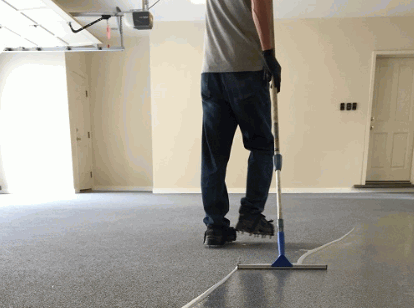
Curing And Finishing The Floor
To ensure a successful epoxy floor garage project, focus on curing and finishing the floor. Allow the epoxy to cure completely for a durable and long-lasting finish. Consider applying a topcoat for added protection, although it’s optional. Lastly, learn how to maintain and clean your epoxy floor to keep it looking pristine.
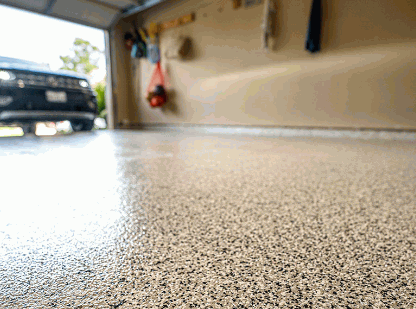
Allowing The Epoxy To Cure
Steps to follow:
- Clean the workspace and make sure it’s well-ventilated and free of dust.
- Read the epoxy manufacturer’s instructions for curing times and conditions.
- Keep the temperature and humidity levels as recommended.
- Allow sufficient time for the epoxy to cure. This could be anywhere from 24 hours to several days.
- Poor curing will affect the floor coating’s durability, so follow these steps carefully.
Applying A Topcoat
Adding a topcoat is not a must, but it can boost the look and longevity of your flooring. Here are 6 steps to apply a topcoat:
- Prep: Clear dust and debris from the surface. Sweep or vacuum.
- Choose: Select a topcoat suitable for your floor type and desired finish. Look at gloss, durability, and ease of application.
- Prime (if needed): Apply primer for bare wood or porous surfaces, as recommended. This helps adhesion.
- Mix: Read instructions, and mix thoroughly to get a consistent finish.
- Apply: Use a brush or roller. Start in one corner, and work to an exit point.
- Dry: Follow the product label for drying time before traffic or furniture. Avoid moisture.
Specific floors may have unique needs for topcoat application. Check manufacturer guidelines.
Fun fact: Topcoats have been used for centuries, but new tech has improved features like durability and drying times.
Maintaining And Cleaning The Epoxy Floor
To keep your epoxy floor lasting long, proper care and cleaning are key. Here is a guide to help you maintain its great look:
- Sweep or vacuum regularly to get rid of any dirt or debris. This will prevent scratches and keep the epoxy looking nice.
- Clean up spills right away with a non-abrasive cleaner and a soft cloth or mop. Don’t use harsh chemicals or scrubbers, as they can harm the epoxy.
- For routine cleaning, mix a mild detergent with warm water and mop gently. Then rinse off all soap residue.
- To remove tough stains or marks, use a pH-neutral cleaner made for epoxy floors. Read the directions and rinse well after.
- Don’t drag heavy furniture or sharp objects, as it can cause scratches or indentations. Put felt pads under the furniture’s legs to avoid damage.
- For high-traffic areas, apply a protective wax or sealer to increase durability and extend the life of your epoxy floor.
Additionally, inspect the floor from time to time for cracks, chips, or wear. Fix any damages right away to prevent further damage and keep your epoxy flooring healthy.
Pro Tip: Don’t use vinegar-based cleaners on epoxy floors, as they can break down the protective layer. Stick to pH-neutral cleaners made for epoxy surfaces to get the best results in cleaning and preserving your epoxy floor.
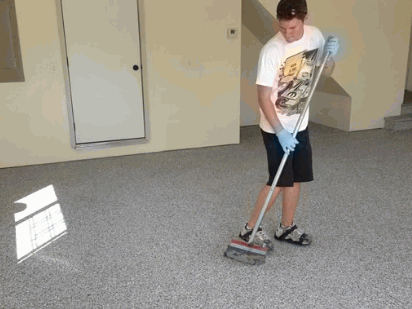
Conclusion
Wrapping up this guide on how to epoxy floor your garage? Careful planning and execution are key. Follow the instructions and you can transform your garage. To guarantee success, get the surface ready: clean and repair any damage.
Get high-quality epoxy products that fit your needs and apply them correctly. Don’t forget the importance of ventilation during the application process. Adequate airflow will make sure you and the epoxy coating stay safe.
If you want a unique touch, add decorative flakes or metallic pigments. This will add visual appeal and extra grip.
